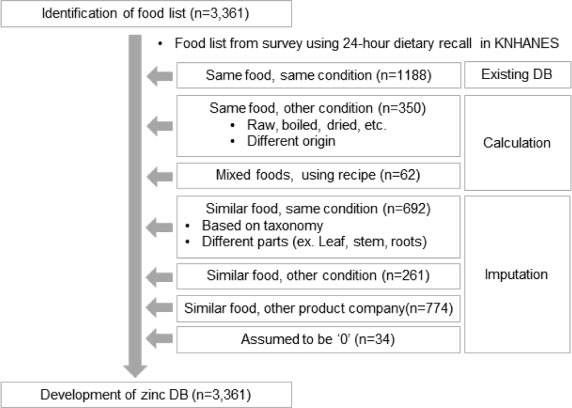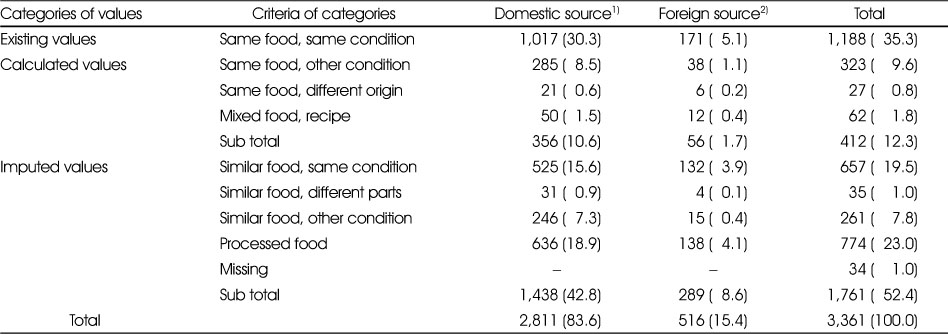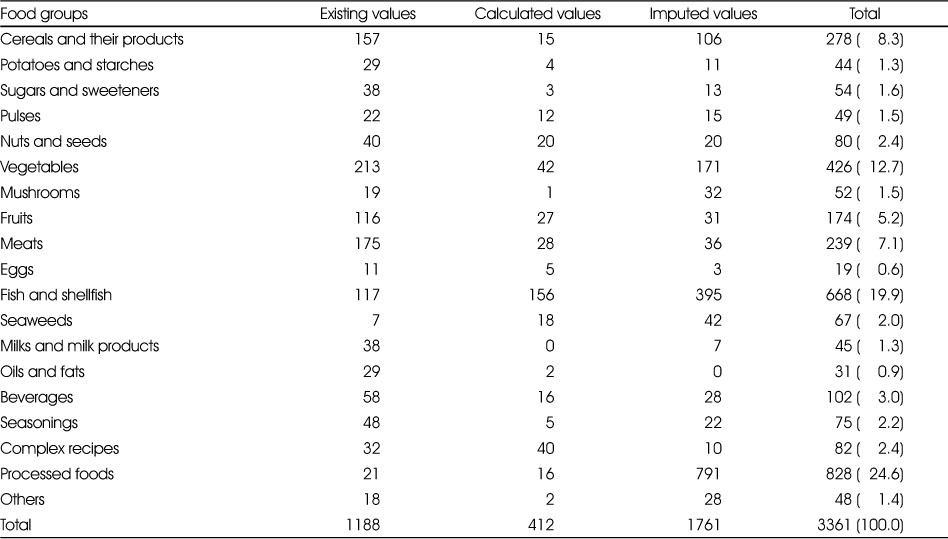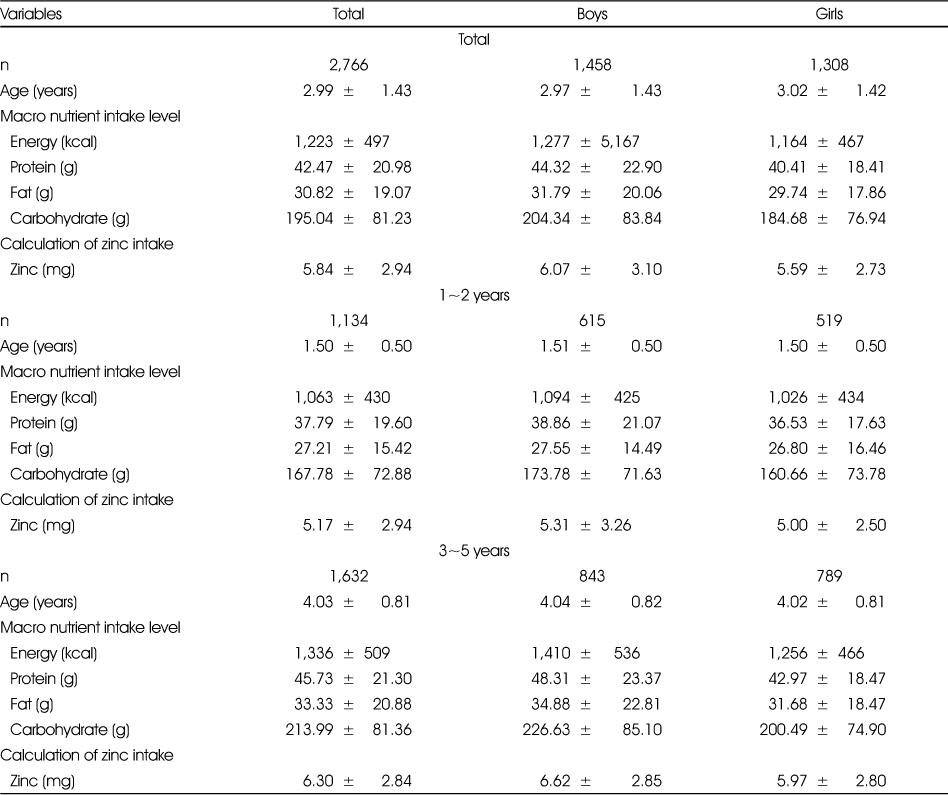Articles
- Page Path
- HOME > Korean J Community Nutr > Volume 26(2); 2021 > Article
- Research Article
- Development of a Zinc Database to Estimate the Zinc Intake Levels in the Korean Toddlers and Preschool Children
- Su-In Yoon, Jae Eun Shim
-
Korean Journal of Community Nutrition 2021;26(2):103-110.
DOI: https://doi.org/10.5720/kjcn.2021.26.2.103
Published online: April 30, 2021

2Professor, Department of Food and Nutrition, Daejeon University, Daejeon, Korea

-
Corresponding author:
Jae Eun Shim, Tel: +82-42-280-2469, Fax: +82-42-280-2468,
Email: jshim@dju.kr
- 1,394 Views
- 5 Download
- 1 Crossref
- 0 Scopus
Abstract
Objectives
The objective of this study was to develop a zinc database (DB) to estimate the intake levels of zinc in Korean toddlers and preschool children using the data from the Korea National Health and Nutrition Examination Survey (KNHANES).
Methods: A total of 3,361 food items for the DB representing the usual diet of Korean toddlers and preschool children were selected based on KNHANES (2009~2013) and the food composition table of Rural Development Administration (RDA). The existing values of zinc in foods were collected from the latest food composition tables of RDA (9th revision) and the US Department of Agriculture (legacy release). The zinc contents were filled preferentially with these collected values. The missing values were replaced with the calculated values or imputed values using the existing values of similar food items from the data source. The zinc intake levels of Korean toddlers and preschool children were estimated using KNHANES and zinc DB Results: A total of 1,188 existing values, 412 calculated values, and 1,727 imputed values were included in the zinc DB. The mean intake levels of zinc for 1-2-year-old children and 3-5-year-olds were 5.17 ± 2.94 mg/day and 6.30 ± 2.84 mg/day, respectively.There was no significant difference in the zinc intake levels between boys and girls in each group.
Conclusions: This newly developed zinc DB would be helpful to assess the zinc nutritional status and investigate the association between the zinc intakes and related health concerns in Korean toddlers and preschool children.
Published online Apr 30, 2021.
https://doi.org/10.5720/kjcn.2021.26.2.103
Development of a Zinc Database to Estimate the Zinc Intake Levels in the Korean Toddlers and Preschool Children
Abstract
Objectives
The objective of this study was to develop a zinc database (DB) to estimate the intake levels of zinc in Korean toddlers and preschool children using the data from the Korea National Health and Nutrition Examination Survey (KNHANES).
Methods
A total of 3,361 food items for the DB representing the usual diet of Korean toddlers and preschool children were selected based on KNHANES (2009~2013) and the food composition table of Rural Development Administration (RDA). The existing values of zinc in foods were collected from the latest food composition tables of RDA (9th revision) and the US Department of Agriculture (legacy release). The zinc contents were filled preferentially with these collected values. The missing values were replaced with the calculated values or imputed values using the existing values of similar food items from the data source. The zinc intake levels of Korean toddlers and preschool children were estimated using KNHANES and zinc DB
Results
A total of 1,188 existing values, 412 calculated values, and 1,727 imputed values were included in the zinc DB. The mean intake levels of zinc for 1–2-year-old children and 3–5-year-olds were 5.17 ± 2.94 mg/day and 6.30 ± 2.84 mg/day, respectively. There was no significant difference in the zinc intake levels between boys and girls in each group.
Conclusions
This newly developed zinc DB would be helpful to assess the zinc nutritional status and investigate the association between the zinc intakes and related health concerns in Korean toddlers and preschool children.
Fig. 1
Overall flow of development of zinc database for the dietary assessment of Korean toddlers and preschool children KNHANES: Korea National Health and Nutrition Examination Survey; DB: database
Table 1
Data sources of zinc database
Table 2
Distribution of food groups and value types in the newly developed zinc database
Table 3
Calculation of zinc intake of Korean toddlers and preschool children with the newly eveloped zinc database using data of the Korea National Health and Nutrition Examination Survey from 2009 to 2013 years and their characteristics of macro nutrient intake by age and sex
Acknowledgments
This work was supported by a grant from the National Research Foundation of Korea (2016R1D1A1B03931820).
References
-
Cronin L, Walton PH. Synthesis and structure of [Zn(OMe)(L)] · [Zn(OH)(L)]·2(BPh4), L = cis, cis-1, 3, 5-tris [(E,E)-3-(2-furyl) acrylideneamino] cyclohexane: Structural models of carbonic anhydrase and liver alcohol dehydrogenase. Chem Commun 2003;13:1572–1573.
-
-
Roohani N, Hurrell R, Kelishadi R, Schulin R. Zinc and its importance for human health: An integrative review. J Res Med Sci 2013;18(2):144–157.
-
-
International Zinc Nutrition Consultative Group (IZiNCG). Brown KH, Rivera JA, Bhutta Z, Gibson RS, King JC, et al. International Zinc Nutrition Consultative Group (IZiNCG) technical document #1. Assessment of the risk of zinc deficiency in populations and options for its control. Food Nutr Bull 2004;25(1 S2):S99–S203.
-
-
Brooks WA, Santosham M, Naheed A, Goswami D, Wahed MA, Diener-West M. Effect of weekly zinc supplements on incidence of pneumonia and diarrhoea in children younger than 2 years in an urban, low-income population in Bangladesh: Randomised controlled trial. Lancet 2005;366(9490):999–1004.
-
-
Gibson RS, Hess SY, Hotz C, Brown KH. Indicators of zinc status at the population level: A review of the evidence. Br J Nutr 2008;99(Suppl 3):S14–S23.
-
-
Lönnerdal B. Dietary factors influencing zinc absorption. J Nutr 2000;130(5S Suppl):1378S–1383S.
-
-
Lee JY, Paik HY, Joung HJ. Supplementation of zinc nutrient database and evaluation of zinc intake of Korean adults living in rural area. Korean J Nutr 1998;31(8):1324–1337.
-
-
Rural Development Administration, National Rural Resources Development Institute (KR). Korean food composition table (9th revision). Wanju-gun, Jeollabuk-do: National Academy of Agricultural Science; 2016.
-
-
Haytowitz DB, Ahuja JKC, Wu X, Somanchi M, Nickle M, Nguyen QA, et al. USDA national nutrient database for standard reference, legacy release [internet]. Nutrient Data Laboratory; Beltsville Human Nutrition Research Center; ARS; USDA; 2019 [cited 2019 Nov 03].Available from: https://data.nal.usda.gov/dataset/usda-
national- nutrient- database- standard- reference- legacyrelease.
-
-
Yoon MO, Kim K, Hwang J, Lee HS, Son TY, Moon H, et al. Development of a fatty acids database using the Korea National Health and Nutrition Examination Survey data. J Nutr Health 2014;47(6):435–442.
-
-
Schakel SF, Sievert YA, Buzzard IM. Sources of data for developing and maintaining a nutrient database. J Am Diet Assoc 1988;88(10):1268–1271.
-
-
Choi IS, Lee KH, Oh SH. A study on the balance of iron and zinc in Korean children. Korean J Community Nutr 1998;3(1):12–20.
-
-
Paik Y, Kweon S, Oh K. Development of fatty acid composition table and intakes of fatty acids in Korea National Health and Nutrition Examination Survey (KNHANES). Wkly Health Dis 2015;8(4):75–81.
-
-
Yeon S, Kweon S, Oh K. Development of dietary fiber composition table and intakes of dietary fiber in Korea National Health and Nutrition Examination Survey VI-3. Wkly Health Dis 2015;10(3):52–58.
-

 KSCN
KSCN





 Cite
Cite


